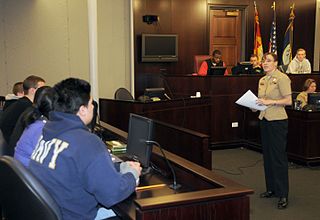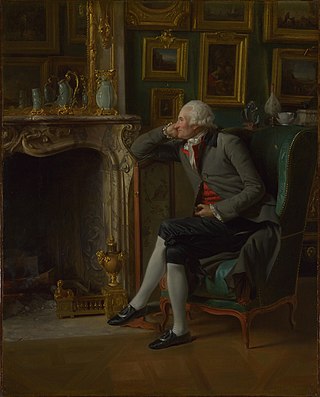The adversarial system or adversary system is a legal system used in the common law countries where two advocates represent their parties' case or position before an impartial person or group of people, usually a judge or jury, who attempt to determine the truth and pass judgment accordingly. It is in contrast to the inquisitorial system used in some civil law systems where a judge investigates the case.
In common law jurisdictions, a preliminary hearing, preliminary examination, preliminary inquiry, evidentiary hearing or probable cause hearing is a proceeding, after a criminal complaint has been filed by the prosecutor, to determine whether there is enough evidence to require a trial. At such a hearing, the defendant may be assisted by a lawyer.
Criminal procedure is the adjudication process of the criminal law. While criminal procedure differs dramatically by jurisdiction, the process generally begins with a formal criminal charge with the person on trial either being free on bail or incarcerated, and results in the conviction or acquittal of the defendant. Criminal procedure can be either in form of inquisitorial or adversarial criminal procedure.
Civil procedure is the body of law that sets out the rules and regulations along with some standards that courts follow when adjudicating civil lawsuits. These rules govern how a lawsuit or case may be commenced; what kind of service of process is required; the types of pleadings or statements of case, motions or applications, and orders allowed in civil cases; the timing and manner of depositions and discovery or disclosure; the conduct of trials; the process for judgment; the process for post-trial procedures; various available remedies; and how the courts and clerks must function.
In a civil proceeding or criminal prosecution under the common law or under statute, a defendant may raise a defense in an effort to avert civil liability or criminal conviction. A defense is put forward by a party to defeat a suit or action brought against the party, and may be based on legal grounds or on factual claims.

Raymond Romain, Comte de Sèze or Desèze was a French advocate. Together with François Tronchet and Malesherbes, he defended Louis XVI, when the King was brought before the Convention for trial. De Sèze is remembered for a speech on Louis' behalf which impressed even his opponents.

A prosecutor is a legal representative of the prosecution in states with either the common law adversarial system or the civil law inquisitorial system. The prosecution is the legal party responsible for presenting the case in a criminal trial against the defendant, an individual accused of breaking the law. Typically, the prosecutor represents the state or the government in the case brought against the accused person.
In United States law, a motion is a procedural device to bring a limited, contested issue before a court for decision. It is a request to the judge to make a decision about the case. Motions may be made at any point in administrative, criminal or civil proceedings, although that right is regulated by court rules which vary from place to place. The party requesting the motion is the moving party or movant. The party opposing the motion is the nonmoving party or nonmovant.

Pierre Victor, baron de Besenval de Brünstatt, also Pierre Victor, baron de Besenval de Brunstatt, was a Swiss military officer in French service.

An opening statement is generally the first occasion that the trier of fact has to hear from a lawyer in a trial, aside possibly from questioning during voir dire. The opening statement is generally constructed to serve as a "road map" for the fact-finder. This is especially essential, in many jury trials, since jurors know nothing at all about the case before the trial,. Though such statements may be dramatic and vivid, they must be limited to the evidence reasonably expected to be presented during the trial. Attorneys generally conclude opening statements with a reminder that at the conclusion of evidence, the attorney will return to ask the fact-finder to find in his or her client's favor.
The legal system of South Korea is a civil law system that has its basis in the Constitution of the Republic of Korea. The Court Organization Act, which was passed into law on 26 September 1949, officially created a three-tiered, independent judicial system. The revised Constitution of 1987 codified judicial independence in Article 103, which states that, "Judges rule independently according to their conscience and in conformity with the Constitution and the law." The 1987 rewrite also established the Constitutional Court, the first time that South Korea had an active body for constitutional review.
Trial advocacy is the branch of knowledge concerned with making attorneys and other advocates more effective in trial proceedings. Trial advocacy is an essential trade skill for litigators and is taught in law schools and continuing legal education programs. It may also be taught in primary, secondary, and undergraduate schools, usually as a mock trial elective.
United States criminal procedure derives from several sources of law: the baseline protections of the United States Constitution; federal and state statutes; federal and state rules of criminal procedure ; and state and federal case law. Criminal procedures are distinct from civil procedures in the US.

The Wisconsin circuit courts are the general trial courts in the state of Wisconsin. There are currently 69 circuits in the state, divided into 10 judicial administrative districts. Circuit court judges hear and decide both civil and criminal cases. Each of the 249 circuit court judges are elected and serve six-year terms.
United States v. Dinitz, 424 U.S. 600 (1976), was a case in which the Supreme Court of the United States determined that the U.S. Const., Amend. V protection against double jeopardy did not prevent a retrial of a defendant, who had previously requested a mistrial.
Glasser v. United States, 315 U.S. 60 (1942), was a landmark decision of the US Supreme Court on two issues of constitutional criminal procedure. Glasser was the first Supreme Court decision to hold that the Assistance of Counsel Clause of the Sixth Amendment required the reversal of a criminal defendant's conviction if his lawyer's representation of him was limited by a conflict of interest.

In court proceedings in the United States, a Perry Mason moment is said to have occurred whenever information is unexpectedly, and often dramatically, introduced into the record that changes the perception of the proceedings greatly and often influences the outcome. Often it takes the form of a witness's answer to a question, but it can sometimes come in the form of new evidence. It takes its name from Perry Mason, a fictional character in novels and stories written by Erle Stanley Gardner, where such dramatic reversals occurred, often in the form of witnesses confessing to crimes others were accused of in response to the sudden exposure of an inconsistency in their alibi.
Pointer v. Texas, 380 U.S. 400 (1965), was a decision by the United States Supreme Court involving the application of the right of to confront accusers in state court proceedings. The Sixth Amendment in the Bill of Rights states that, in criminal prosecutions, the defendant has a right "...to be confronted with the witnesses against him; to have compulsory process for obtaining witnesses in his favor..." In this case, a person arrested in Texas for robbery was deprived of the ability to cross-examine a witness when the lower court allowed the introduction of a transcript of that witness's earlier testimony at a preliminary proceeding instead of compelling attendance by the witness at trial.
Cone v. Bell, 556 U.S. 449 (2009), was a case in which the United States Supreme Court held that a defendant was entitled to a hearing to determine whether prosecutors in his 1982 death penalty trial violated his right to due process by withholding exculpatory evidence. The defendant, Gary Cone, filed a petition for postconviction relief from a 1982 death sentence in which he argued that prosecutors violated his rights to due process under the Fourteenth Amendment by withholding police reports and witness statements that potentially could have shown that his drug addiction affected his behavior. In an opinion written by Justice John Paul Stevens, the Supreme Court held that Cone was entitled to a hearing to determine whether the prosecution's failure to disclose exculpatory evidence violated Cone's right to due process; the Court noted that "the quantity and the quality of the suppressed evidence lends support to Cone’s position at trial that he habitually used excessive amounts of drugs, that his addiction affected his behavior during his crime spree". In 2016, Gary Cone died from natural causes while still sitting on Tennessee's death row.

Lèse-nation, also lèze-nation, was a crime defined in France in connection with the French Revolution. The law regarding the crime of lèse-nation was in force between 1789 and 1791. It was immediately after the proclamation of the sovereignty of the nation, in the aftermath of the Tennis Court Oath from 20 June 1789, that the foundation for the law regarding the crime of lèse-nation was laid. On 23 June 1789, the National Assembly announced that it will prosecute as criminals all those who, individuals or bodies, attack its existence or the freedom of its members.







